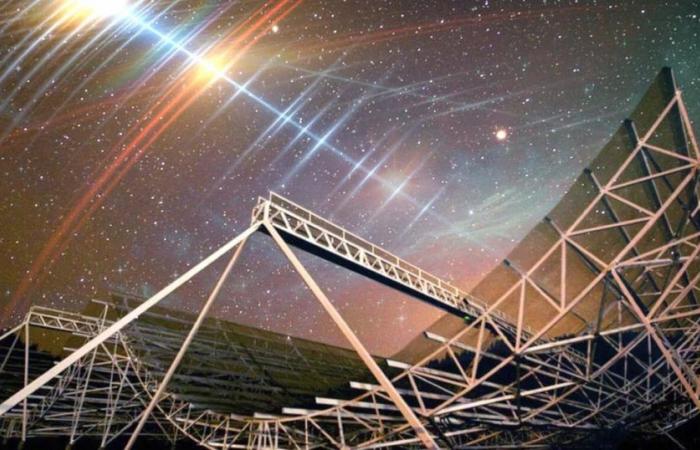In addition to the observations with large ground and space telescopes, There is a way that for decades has sought the answer to the great question that human beings have asked themselves for centuries: Are we alone in the universe? And this way is through radio signals that reach our planet.
Continuously and for decades, Large radio telescopes scan the skies to capture any signals from deep space. Generally, what is identified has to do with manifestations related to distant star explosions. But in recent weeks something out of the ordinary caught the attention of a group of international astronomers. Their findings were published in Nature Astronomy.
“Recently, We discovered a radio transient that is unlike anything astronomers have seen before. Not only does it have a nearly hour-long cycle (the longest ever seen), but over several observations we saw it sometimes emitting long, bright flashes, sometimes fast, weak pulses, and sometimes nothing at all. We cannot fully explain what is happening here. “The most likely thing is that it is a very unusual neutron star, but we cannot rule out other possibilities,” explained the doctor in astronomy Manisha Caleb.
The expert stated that “when astronomers point radio telescopes into space, we sometimes detect sporadic bursts of radio waves originating from the vast expanse of the universe. We called them ‘radio transients’“Some erupt only once and are never seen again, and others flash on and off in predictable patterns.”
And he maintained: “We believe that most radio transients come from rotating neutron stars known as pulsars, which emit regular flashes of radio waves, like cosmic lighthouses. Typically, these neutron stars spin at incredible speeds, taking just a few seconds or even a fraction of a second to complete each rotation.”
The strange signal would come from a neutron star called ASKAP J1935+2148, located in the plane of the Milky Way, about 15,820 light years from Earth. But the signs themselves are unlike any we’ve seen before. The star goes through periods of strong pulses, periods of weak pulses, and periods of no pulse at all.
What we don’t know, according to the team led by the Caleb astrophysicist of the University of Sydney in Australia, is the reason. The strange object poses a fascinating challenge to the models of neutron star evolution analyzed. It must be explained that a neutron star is what remains after a star dies within a certain mass range, between approximately 8 and 30 times the mass of the Sun. The outer material of that sun is launched into space, culminating in a supernova explosion.
Then, The star’s leftover core collapses under gravity, forming an ultradense object up to 2.3 times the mass of the Sun, in a sphere only 20 kilometers in diameter. The resulting neutron star itself can come in various forms, such as a base neutron star, that simply sits around without doing much, or a pulsar, which sweeps beams of radio emission from its poles as it spins, flashing like a cosmic beacon.
And there is also the magnetar, a neutron star with an extremely powerful magnetic field, that shakes and explodes when the external attraction of that magnetic field fights against the gravity that holds the star together. Another example may be when some strange crossing occurs between the types of neutron stars, suggesting that they may be different stages of neutron star evolution. However, in general, pulsars, magnetars, and neutron stars tend to behave in relatively predictable ways.
Scientists claim that ASKAP J1935+2148 does not behave normally for a neutron star of any established type. This signal was first identified serendipitously during observations of a different target, and follow-up observations were made using the Australian Square Kilometer Array Pathfinder (ASKAP) and the MeerKAT radio telescope in South Africa.
The researchers also dove into previous ASKAP observations that covered the same area of the sky. And they discovered that ASKAP J1935+2148 has a regular pulsation period of 53.8 minutes, an extremely bright pulsation mode, with a very linear polarization. But then it would disappear completely, with no measurable pulsations for a period. Finally, it was detected thatThe star resumed its pulsation activity, but 26 times weaker than its previous bright mode and with circularly polarized light.
We don’t know for sure what these objects are, but it seems likely that they are neutron stars. And ASKAP J1935+2148, Caleb and his colleagues suggest, could be a kind of bridge between the different states.
The differences between their pulsation modes are likely related to magnetospheric changes and processes, suggesting that all the objects belong to a new class of magnetars, possibly as they evolve into pulsars.
“ASKAP J1935+2148 is probably part of an older population of magnetars with long spin periods and low X-ray luminosities, but sufficiently magnetized to be able to produce coherent radio emissions,” the researchers write in their article.
“It is important that we probe this hitherto unexplored region of neutron star parameter space to obtain a complete picture of neutron star evolution, and this may be an important source for doing so,” they concluded.






